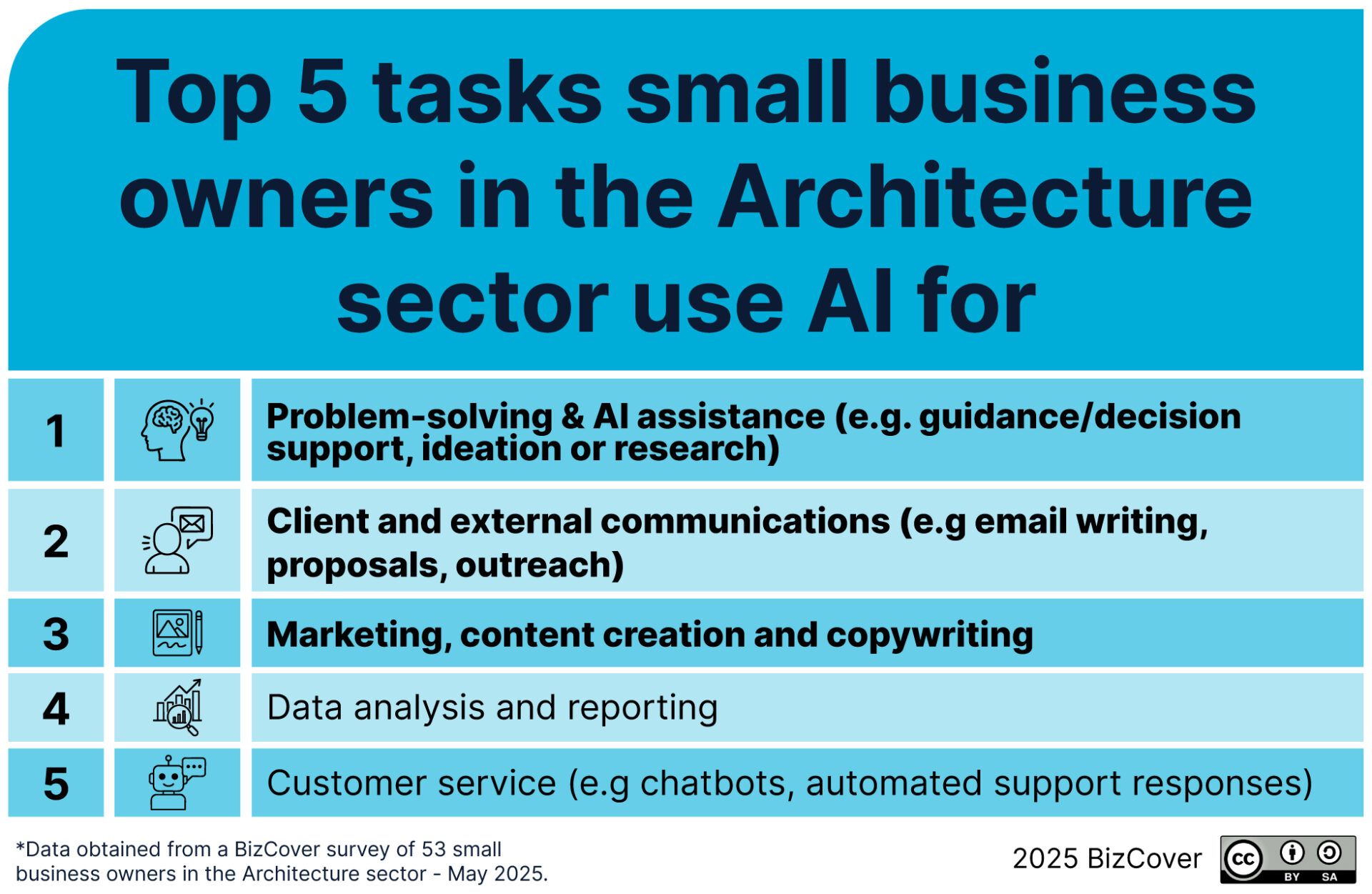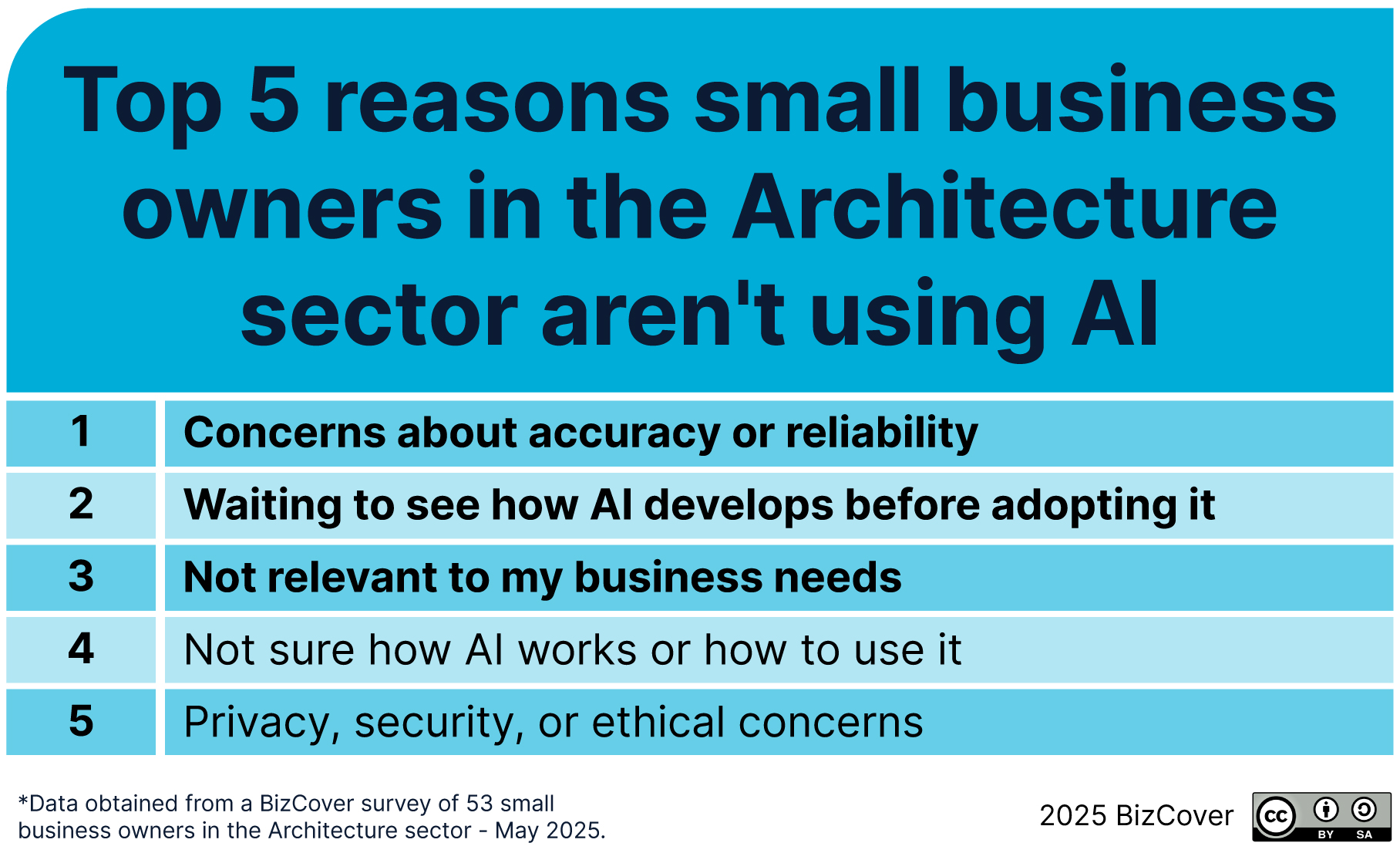How Architecture Businesses Are Adapting to AI in 2025
AI is gaining serious traction in the Australian SME business landscape. But some industries are approaching this emerging technology much slower than others.
According to the Australian Small Business AI Report 2025, 80% of Australian small businesses are using or planning to adopt AI in the near future. However, out of all the industries surveyed, architecture has one of the slowest adoption rates. And while many people within the sector acknowledge AI’s importance in the future of architecture, they are still taking a measured response towards integration.
“Architecture is a sector that is curious about AI’s potential, but it’s not looking to rush into things straight away,” says Brad Hoyle, Head of Operational Excellence at BizCover. “Rather than risking moving too quickly, architects are exploring how AI can support tasks like communications, project planning and data analysis – which should help them focus more on design and client relationships.”
In a shifting business landscape, how will the architecture sector keep up? The below report details findings from 53 businesses in the architecture sector, giving a rounded view on their stance towards AI, alongside commentary from Brad Hoyle.
Key takeaways
- Growing AI adoption: 60% of architects currently use AI, and 81% either use or plan to adopt it, though the sector has one of the highest rates of hesitation (21%) and rejection (19%).
- Support tool, not design lead: AI is primarily used for administrative support, communications, and planning. 63% of architects say AI could replace tasks, but only 8% believe it could replace full roles, showing a strong belief in the value of human-led design.
- Skills under pressure: 34% say hard skills are the hardest to hire for. Many are upskilling in areas like automation and AI, while still prioritising problem-solving, creativity, and project management.
- Mixed sentiment, measured optimism: 57% feel positive about AI’s impact on their career, but the sector also has the highest concern level about AI having a negative impact (19%).
- Creative core remains human: Estimators, computer-aided design (CAD) technicians, and building information modelling (BIM) specialists are seen as the most at-risk roles, but designers and architects themselves are largely seen as irreplaceable. AI is seen as a workflow enhancer, not a substitute for architectural expertise.
AI adoption in the architecture sector: Current usage and trends
AI adoption in the architecture sector is progressing, but much more slowly compared to other industries. Currently, 60% of architecture businesses use AI technology, while an additional 21% plan to adopt it within the next two years. Meanwhile, 19% of architects have no plans to use AI in the future. This is the second highest rejection rate across all industries surveyed, just behind health (32%).
Despite this slower approach, 53% of architects say AI is already important to their day-to-day operations. While this number falls far short of marketing (87%) and consulting (75%), this indicates that many in the industry are already benefiting from early AI adoption.
“Architecture has the highest proportion of business owners still in the ‘not yet’ phase of AI adoption,” notes Hoyle. “It shows a level of caution we’re not seeing in other sectors, but I believe there is also a real opportunity for innovation as more firms begin to test the waters.”

AI usage within architecture businesses
While AI is only slowly gaining traction in the architecture sector, early adopters are already finding ways to put it to work. The top three uses of AI among architects include:
- Problem solving and critical thinking.
- Client and external communications.
- Marketing, content creation and copywriting.
These findings suggest that AI is primarily being explored as a support tool, rather than as a design engine. Architecture firms are using AI to streamline communication, improve operational efficiency, and assist with administrative and planning tasks. Having AI handle these tasks provides architects with more time for high-value, skilled creative work.
“While architects are still wary about using AI for core design, they’re beginning to see its potential to improve the way their businesses operate day-to-day,” says Hoyle.

Barriers to AI adoption in architecture
Despite growing interest in AI, many architecture businesses are taking a wait-and-see approach. The most common barriers to adoption include:
- Concerns about accuracy and reliability.
- Waiting to see how AI develops before using it.
- Perceived lack of relevance to their business needs.
These barriers show that many architects are waiting for clearer proof of AI’s value, or simply don’t see how it fits into their current workflows.

AI’s importance to daily operations in architecture
Just over half of architecture professionals (53%) say AI is important to their daily operations. 48% say it is only somewhat important or not very important, while 23% say it’s not important at all.
However, this sentiment shifts when looking to the future. When asked about AI’s long-term impact, only 8% believe it will have little to no effect on their business.
So while AI may not yet be central to many architectural businesses, many expect its influence to grow. For now, AI adoption in architecture seems to be in an exploratory phase, with businesses taking an unhurried approach to testing.
“Many architectural firms don’t see AI yet as critical or even essential,” says Hoyle. “But there’s a clear expectation that it will become more relevant as the tools mature and align more closely with how architects work. The next few years will be very interesting to see how this industry evolves.”

AI’s impact on skills in the architecture sector
What will the architecture sector look like in the next few years? Nearly half (47%) of architects expect AI to create demand for entirely new skillsets within the next 3 to 5 years; while at the same time, 51% believe AI will reduce the need for some existing skills. This clearly shows that the industry is expecting to adapt to fit the needs of a changing workforce.
This mindset could be impacted by the skills shortage in the architectural sector. Only 17% of respondents say they have no difficulty finding skilled professionals. Of the rest, 34% report challenges sourcing technical (hard) skills, while another third struggle to find candidates with a combination of both hard and soft skills.
Looking to the future, architects are optimistic about AI’s ability to enhance core capabilities, which could also help combat this skills shortage:
- 60% expect improvements in coding and software development.
- Over 50% see benefits in project management and creative output.
- 53% believe AI will enhance creativity and innovation.
“While uptake has been slow, it seems like architects are generally positive about AI and its ability to enhance creative abilities,” says Hoyle. “People see that it can be used to complement the design process, instead of stifling creativity.”
However, there are still some concerns around AI’s role in the future, with 38% of architects anticipating a decline in interpersonal and social abilities. This suggests that while AI is welcomed as a technical and creative enabler, many in the field feel it could weaken human connection and collaboration.
What skills are architects investing in?
Architects rely on a combination of problem-solving, critical thinking and technical expertise to bring creative designs to life. But as AI continues to transform the business landscape in Australia, architectural professionals are upskilling to stay ahead of the curve.
To remain competitive and relevant, many architects are actively upskilling in both technical and creative domains. This includes investing in:
- Technical skills (such as cybersecurity, coding and industry-specific technology).
- Automation and data analysis (such as machine learning and AI-driven decision-making).
- Creativity and innovation.
This dual investment in technical and creative skills reflects the changing nature of the profession.

Could AI replace human workers in the architecture sector?
AI is beginning to make its mark on architectural businesses, but this seems to be happening mostly at the fringes.
71% of architects believe AI could replace either tasks or full job roles within their business. However, the vast majority (63%) say that AI is more likely to replace specific tasks, rather than entire roles. Only 8% believe AI could replace both tasks and full jobs.
“This signals that most people in the [architecture] industry feel that AI’s role will be assistive, not disruptive,” says Hoyle.
The most commonly identified functions that could be replaced by AI include:
- Administrative tasks
- Marketing and content creation
- Data analysis.
When it comes to resourcing, opinions are split. 43% of architects say they would be likely (or actively choose) to use AI tools instead of hiring or outsourcing certain tasks; but 45% say they are unlikely to do this. 11% completely refuse to replace or outsource human roles with AI. These statistics reinforce the profession’s reliance on creativity and collaboration. It also aligns with the fact that 19% of respondents answered that they had no plans to use AI in the future at all – a comparatively high rejection rate.

Sentiment towards AI’s future impact in the architecture sector
Architects are approaching AI with tentative optimism.
57% of professionals in the architecture sector feel positive about AI’s impact on their skills and careers, seeing it as a tool that could enhance creativity, streamline workflows and improve project management.
On the other hand, the industry also shows the highest level of concern among all sectors surveyed, with 19% expressing worry about staying relevant or their skills becoming obsolete. This level of unease reflects architecture’s deep reliance on human interpretation, creativity and emotional intelligence – exactly the kind of traits not easily replicated by machines.
A further 25% of architects say they feel neutral, indicating they don’t expect AI to significantly alter their day-to-day work in the near future.
Together, these findings suggest that while many in the industry ae open to using AI as a productivity and support tool, there are still serious concerns about its long-term role.
“Architects understand that AI can assist with efficiency, but they also recognise that design is more than data. it’s about context, emotion, experience,” says Hoyle. “That’s why there seems to be both curiosity and caution when it comes to AI.”

Conclusion: The industry will engage with AI on its own terms
The architectural sector is generally optimistic about AI, but the industry wants to adopt AI on its own terms.
Despite growing interest and usage, architecture remains one of the more circumspect sectors. Architects primarily see AI as a supportive tool – one that boosts efficiency in administrative tasks, data analysis and project management. It can help to streamline routine work, augment human skills and open up new possibilities without replacing architectural expertise.
As the profession evolves, so too does its workforce. Architects are actively upskilling in areas such as coding, automation and data literacy, while continuing to hone critical thinking and creative problem-solving. This should help to ensure they remain competitive in a shifting technological landscape.
Overall, architecture professionals are optimistic about AI’s potential to improve workflows and enhance project outcomes, while staying grounded in the importance of artistry and human judgement.
Need help protecting your architecture business as technology evolves? BizCover makes it easy to compare business insurance tailored to your needs—fast, online, and hassle-free. For on the go cover, go BizCover.
Methodology
This research was conducted via an online survey distributed to Australian business owners in April 2025. A total of 1,323 responses were collected. For the purposes of this analysis, only responses from small business owners (defined as those with 20 or fewer employees) were included, bringing the final sample size to 965.
These respondents represented seven industries, after excluding two industries with low response rates (fewer than 50 responses each) to ensure meaningful comparison. The remaining industries include Architecture, Marketing and Communications, Consulting and Strategy, ICT, Healthcare and Medical, and others. There were 53 respondents from the Architecture sector.
Respondents were asked a mix of multiple choice and checkbox questions covering AI adoption, its impact on operations and roles, and evolving skill requirements. The data has been analysed to highlight trends across small business owners, industries, and anticipated future use of AI in the small business sector.
© 2025 BizCover Pty Limited, all rights reserved. ABN 68 127 707 975; AFSL 501769
This information is general only and does not take into account your objectives, financial situation or needs. It should not be relied upon as advice. As with any insurance, cover will be subject to the terms, conditions and exclusions contained in the policy wording or Product Disclosure Statement (available on our website). Please consider whether the advice is suitable for you before proceeding with any purchase. Target Market Determination document is also available (as applicable). © 2025 BizCover Pty Limited, all rights reserved. ABN 68 127 707 975; AFSL 501769.


![[Press Release] Power loss biggest threat to Australian businesses as storm and fire season approach](https://www.bizcover.com.au/wp-content/uploads/Power-loss-biggest-threat-to-Australian-businesses-as-storm-and-fire-season-approach-1.png)
